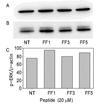Abstract
Purpose
Fibronectin(FN), one of the major components of ECM, mediates wide variety of cellular interactions including cell adhesion, migration, proliferation and differentiation. In this study, we used synthetic peptides based on fibrin binding sites of amino-terminal of FN and evaluated their biologic effects on periodontal ligament(PDL) cells.
Materials and methods
PDL cells were cultured on synthetic oligopeptides coated dishes and examined for cell adhesion, proliferation via confocal microscope. For detection of ERK1/2, cells were plated and Western blot analysis was performed.
Figures and Tables
 | Figure 1PDL cell attachment using confocal laser microscopy. Nuclei appear blue, and actin filaments are red. (A) NT, (B) FF1, (C) FF3, (D) FF5 |
 | Figure 2MTT assay of PDL cell attachment in 1 hour. *denotes a statistically significant differences between control and test group (P<0.05). †denotes statistically significant differences between test groups(P<0.05). |
 | Figure 3Activation of ERK1/2 in PDL cells cultured on synthetic oligopeptide. Phosphorylation levels of p-ERK1/2 were quantified by densitometry. Immunoblotting after treatment with 20µM of each peptide. (A) Phosphorylated ERK1/2, (B) β-actin, (C) The levels of p-ERK1/2 were quantified by densitometric scanning |
References
1. Damsky CH. Extracellular matrix-integrin interactions in osteoblast function and issue remodeling. Bone. 1999; 25:95–96.

2. Embery G, Waddington RJ, Hall RC, Last KS. Connective tissue elements as diagnostic aids in periodontology. Periodontol. 2000; 24:193–214.

3. Isaka J, Ohazama A, Kobayashi M, et al. Participation of periodontal ligament cells with regeneration of alveolar bone. J Periodontol. 2001; 72:314–323.

4. Seo BM, Miura M, Gronthos S, et al. Investigation of multipotent postnatal stem cells from human periodontal ligament. Lancet. 2004; 364:149–155.

5. Magnus KM, Deane FM. Fibronectin: structure, assembly, and cardiovascular implications. Arterloscler Thromb Vasc Biol. 1998; 18:1363–1370.
6. Kapila YL, Lancero H, Johnson PW. The response of periodontal ligament cells to fibronectin. J Periodontol. 1998; 69:1008–1019.

7. Lukinmaa PL, Mackie EJ, Thesleff I. Immunohistochemical localization of the matrix glycoproteins-tenascin and ED sequence-containing form of cellular fibronectin-in human permanent teeth and periodontal ligament. J Dent Res. 1991; 70:19–26.

8. Plow EF, Haas TA, Zhang L, Loftus J, Smith JW. Ligand binding to integrins. J Biol Chem. 2000; 275:21785–21788.

9. Agueda AR, Jean ES, Leslie IG. Comparison of the fibrin-binding activities in the N- and C-termini of fibronectin. Biochem J. 1999; 338:375–386.

10. Sousa SR, Lamghari M, Sampaio P, Moradas-Ferreira P, Barbosa MA. Osteoblast adhesion and morphology on TiO2 depends on the competitive preadsorption of albumin and fibronectin. J Biomed Mater Res A. 2008; 84:281–290.
11. Greiling D, Clark RA. Fibronectin provides a conduit for fibroblast transmigration from collagenous stroma into fibrin clot provisional matrix. J Cell Sci. 1997; 110:861–870.

12. Grzesik WJ, Ivanov B, Robery FA, Southerland J, Yamauchi M. Synthetic integrin-binding peptides promote adhesion and proliferation of human periodontal ligament cells in vitro. J Dent Res. 1998; 77:1606–1612.

13. Kantlehner M, Schaffner P, Finsinger D, et al. Surface coating with cyclic RGD peptides stimulates osteoblast adhesion and proliferation as well as bone formation. Chembiochem. 2000; 1:107–114.

14. De Giglio E, Sabbatini L, Colucci S, Zambonin G. Synthesis, analytical characterization, and osteoblast adhesion properties of RGD-grafted polypyrrole coatings on titanium substrates. J Biomater Sci Polymer Ed. 2000; 10:1073–1083.
15. Ku Y, Chung CP, Jang JH. The effect of the surface modification of titanium using a recombinant fragment of fibronectin and vitronectin on cell behavior. Biomaterials. 2005; 26:5153–5157.

16. Park JW, Lee SG, Choi BJ, Suh JY. Effects of a cell adhesion molecule coating on the blasted surface of titanium implants on bone healing in the rabbit femur. Int J Oral Maxillofac Implants. 2007; 22:533–541.
17. Williams MJ, Phan I, Harvey TS, et al. Solution structure of a pair of fibronectin type 1 modules with fibrin binding activity. J Mol Biol. 1994; 235:1302–1311.

18. Blystone SD, Weston LK, Kaplan JE. Fibronectin dependent macrophage fibrin binding. Blood. 1991; 78:2900–2907.

19. Corbett SA, Lee L, Wilson CL, Schwarzbauer JE. Covalent cross-linking of fibronectin to fibrin is required for maximal cell adhesion to a fibronectin-fibrin matrix. J Biol Chem. 1997; 272:24999–25005.

20. Grinnel F, Feld M, Minter D. Fibroblast adhesion to fibrinogen and fibrin substrata: requirement for cold-insoluble globulin (plasma fibronectin). Cell. 1980; 19:517–525.

21. Corbett SA, Wilson CL, Schwarzbauer JE. Changes in cell spreading and cytoskeletal organization are induced by adhesion to a fibronectin-fibrin matrix. Blood. 1996; 88:158–166.

22. Clark RA, Lin F, Greiling D, An J, Couchman JR. Fibroblast invasive migration into fibronectin/fibrin gels requires a previously uncharacterized dermatan sulfate-CD44 proteoglycan. J Invest Dermatol. 2004; 122:266–277.

23. Knox P, Crooks S, Rimmer CS. Role of fibronectin in the migration of fibroblasts into plasma clots. J Cell Biol. 1986; 102:2318–2323.

24. Gumbiner BM. Cell adhesion: the molecular basis of tissue architecture and morphogenesis. Cell. 1996; 84:345–357.

25. Zhu X, Assoian RK. Integrin-dependent activation of MAP kinase: A link to shape-dependent cell proliferation. Mol Biol Cell. 1995; 6:273–282.

26. Leung WK, Wu Q, Hannam PM, McBride BC, Uitto VJ. Treponema denticola may stimulate both epithelial proliferation and apoptosis through MAP kinase signal pathways. J Periodontal Res. 2002; 37:445–455.

27. Takeuchi Y, Suzawa M, Kikuchi T, et al. Differentiation and transforming growth factor-beta receptor down-regulation by collagen-alpha2 beta1 integrin interaction is mediated by focal adhesion kinase and its downstream signals in murine osteoblastic cells. J Biol Chem. 1997; 11. 14. 272:29309–29316.

28. Xiao G, Gopalakrishnan R, Jiang D, et al. Bone morphogenetic proteins, extracellular matrix, and mitogen-activated protein kinase signaling pathways are required for osteoblast-specific gene expression and differentiation in MC3T3-E1 cells. J Bone Miner Res. 2002; 01. 17:101–110.

29. Kaori M, Motohiro K, Kenko I, Isao I. Extracellular signaling-regulated kinase1/2 is involved in ascorbic acid-induced osteoblastic differentiation in periodontal ligament cells. J Periodontol. 2007; 78:328–334.
30. Kim TI, Jang JH, Lee YM, et al. Design and biological activity of synthetic oligopeptides with Pro-his-Ser-Arg-Asn (PHSRN) and Arg-Gly-Asp(RGD) motifs of human osteoblast-like cell(MG-63) adhesion. Biotechnology letters. 2002; 24:2029–2033.




 PDF
PDF ePub
ePub Citation
Citation Print
Print



 XML Download
XML Download